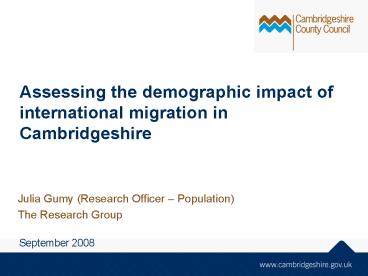Assessing the demographic impact of international migration in Cambridgeshire - PowerPoint PPT Presentation
1 / 25
Title:
Assessing the demographic impact of international migration in Cambridgeshire
Description:
Take up summer jobs and learn English. Mostly young. Evidence of some families with children ... evidence for the NHS Cambridgeshire priorities. Policy ... – PowerPoint PPT presentation
Number of Views:19
Avg rating:3.0/5.0
Title: Assessing the demographic impact of international migration in Cambridgeshire
1
Assessing the demographic impact of international
migration in Cambridgeshire
Julia Gumy (Research Officer Population) The
Research Group
September 2008
2
Outline of the presentation
- Aim of the research
- Migration in Cambridgeshire
- Data and Methodology
- Results
- Policy implications
- Conclusions
3
Why migration?
- Apparent increase in international migration
- Questions
- Is migration really increasing?
- Can we measure it?
- Which are the areas affected?
- Which are the main groups migrating?
- How does this affect our population?
- Which services do we need to provide?
4
Aim of the research
- To assess the current and future impact of
international migration in Cambridgeshires
population...... - ..with a focus on migrant workers
5
Data sources
6
Limitations of the data
- Administrative data sources not designed to
monitor migration - Ilustrate inflows but not outflows
- No indication on length of stay
- Do not represent stock of migrants
- Data sources cannot be linked, which means
- Different sample of overseas citizens
- Different fields of information
- Different time periods
- Data cannot provide estimates of the number of
migrants in Cambridgeshire or elsewhere
7
Strengths of the data
- Allow us to study trends
- When compared, the data can confirm observed
patterns - Provide information at small geographical areas
- Some data sources can be indicators of intended
length of stay (e.g. GP data, ESOL enrolments)
8
Methodology
- Collection of the data since the year 2001
- Data cleansing and re-organisation
- Categorisation in continents of origin
- Reconciliation of the NINos and WRS where
possible - Analysis and comparison of data sources
- Trend analysis
- Estimation of international migration
9
Methodology
- No data on length of stay or intentions
- Development of return rate scenarios
- Result most likely estimate of the number of
migrant workers in Cambridgeshire
10
Cambridgeshire
- In the 2001 Census, 9 of the population in
Cambridgeshire was born outside the UK
Source 2001 Census
11
Rank of LAs in the EoE
12
Rank of Cambridgeshire districts in the UK
13
Work registrations by continent of origin in
Cambs
Around 30,000 non-UK born people have registered
to work in Cambridgeshire since 2001
The highest numbers of migrants are Polish,
Lithuanians and Indians
14
Work registrations by year of registration in
Cambs
Source NINOs data
15
Work registrations by district and nationality
in Cambs
Source NINOs
16
Impact in Cambridgeshire
- Our best estimate is 61,500 non-UK born people
in Cambridgeshire - 11 of the current population, 2 percentage
points more than in 2001 - Most of the non-UK population would be Western
European and Asian - ONS estimates 69,000 (CI /- 14,000) non-UK born
citizens in Cambs (Source Annual Population
Survey)
17
Change since 2001
Sources 2001 Census, NINos/WRS data
18
Characteristics of migrants
- Eastern Europeans
- Short-term migrants
- Young (18-34)
- Mostly males
- Unaccompanied
- Employment dependant on the district
- Do not register with a GP (or perhaps not
immediately) - Not many registered for language courses
19
Characteristics of migrants
- Western Europeans
- High presence in industrial areas
- Employment linked to high-tech industry or
University - Short-term migration patterns
- Take up summer jobs and learn English
- Mostly young
- Evidence of some families with children
- Do not register with a GP
- Not many registered for language courses
20
Characteristics of migrants
- Asians
- Constant flow of Asians
- Decrease in the number of registrations
- Evidence of some families with children
- Americans
- Mostly linked to the armed forces
- Africans
- Low numbers
- Most migrants from South Africa
- Oceania
- Most migrants from Australia
21
Policy Implications
- Identification of priorities based on results
- Two examples
- Community Cohesion Strategy
- Targeted communication measures
- Access to guidance for employers to set minimum
standards for migrant workers - Joint Strategic Needs Assessment
- Identify gaps and inequalities in the provision
of health care - Provide evidence for the NHS Cambridgeshire
priorities
22
Conclusions
The demographic impact
- International migration has increased since 2001
- How does this affect Cambridgeshires population?
- We estimate that 11 of Cambridgeshires
population in 2006 was born outside the UK,
indicating a slight increase since 2001, when the
Census counted 9 - The origin mix could have slightly changed
- Western Europeans and Asians would be the largest
groups of non-UK born people in Cambridgeshire - We found evidence to suggest numbers of new
migrants may have already begun to decline
23
Conclusions
- Measurement of migration
- We need better data
- Data tailored to study migration
- Better quality of the data
- More harmonisation
- Easier data linkage
- Information at small geographical levels
- Better data protection
- Development of large scale longitudinal surveys
- New Migrant Databank (NMD)
- Population register - National Identity Register
(NIR) - 2011 Census
24
Conclusions
- Promote information sharing between academic and
local government research - To improve understanding of migration flows
- Fill knowledge gaps
- Share knowledge
- Share best practices
- Achieve good quality results
25
For more information
- The Research Group
- Cambridgeshire County Council
- Shire Hall
- Castle Hill
- Cambridge
- CB3 0AP
- E-mail research.group_at_cambridgeshire.gov.uk
- Tel 01223 715300































